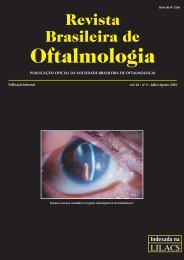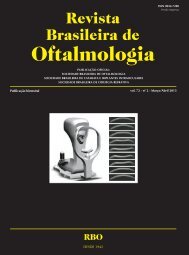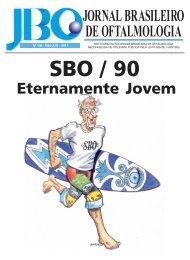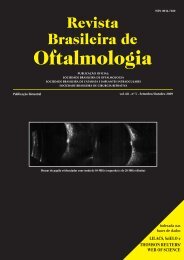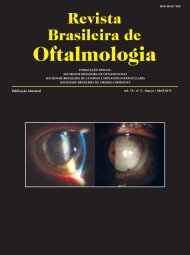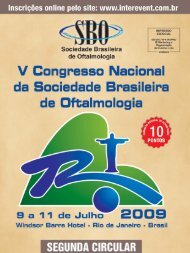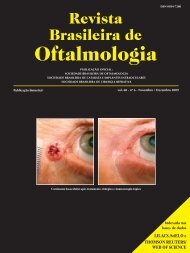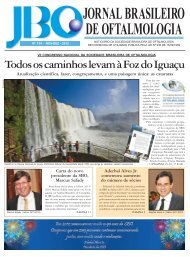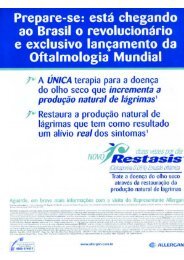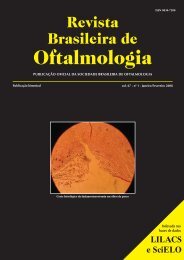Jan-Fev - Sociedade Brasileira de Oftalmologia
Jan-Fev - Sociedade Brasileira de Oftalmologia
Jan-Fev - Sociedade Brasileira de Oftalmologia
- No tags were found...
Create successful ePaper yourself
Turn your PDF publications into a flip-book with our unique Google optimized e-Paper software.
48<br />
RELATO DE CASO<br />
Retinal nerve fiber layer loss documented<br />
by optical coherence tomography<br />
in patients with optic tract lesions<br />
Perda da camada <strong>de</strong> fibras nervosas retinianas<br />
documentada pela tomografia por coerência óptica<br />
em pacientes com lesões do trato óptico<br />
Mário Luiz Ribeiro Monteiro 1 , Kenzo Hokazone 2<br />
ABSTRACT<br />
Purpose: To report abnormalities of retinal nerve fiber layer (RNFL) thickness using<br />
Stratus - optical coherence tomography (OCT) in two patients with optic tract lesions.<br />
Methods: Two patients with long standing homonymous hemianopia from optic tract<br />
lesions were submitted to a complete neuro-ophthalmic evaluation and to Stratus -<br />
optical coherence tomography examination. Results: Both patients revealed diffuse<br />
loss of the RNFL at Stratus – OCT in both eyes. In the eyes with the temporal hemianopia,<br />
RFNL loss was diffuse but predominantly in the nasal and temporal areas of the optic<br />
disc, the classic pattern of band atrophy of the optic nerve. In the eyes with nasal<br />
hemianopia RNFL loss could be documented in the superior and inferior quadrants of<br />
the optic disc. RNFL loss correlated well with visual field loss and the expected pattern<br />
of RNFL loss in optic tract lesions. Conclusion : Stratus-Optical coherence tomography<br />
can provi<strong>de</strong> useful information in the diagnosis of optic tract lesions by i<strong>de</strong>ntifying the<br />
characteristic pattern of RNFL loss that occurs in both eyes in this condition.<br />
Keywords: Retinal ganglion cells; Tomography, optical coherence; Visual pathways /<br />
abnormalities; Nerve fiber/ultrastructure; Diagnostic techniques, ophthalmological<br />
1<br />
Livre-docente, Professor associado da Faculda<strong>de</strong> <strong>de</strong> Medicina da Universida<strong>de</strong> <strong>de</strong> São Paulo – USP – São Paulo (SP), Brasil;<br />
2<br />
Médico colaborador do Setor <strong>de</strong> Neuroftalmologia da Divisão <strong>de</strong> Clínica Oftalmológica do Hospital das Clínicas da Faculda<strong>de</strong> <strong>de</strong><br />
Medicina da Universida<strong>de</strong> <strong>de</strong> São Paulo – USP – São Paulo (SP) – Brasil.<br />
Divisão <strong>de</strong> Clínica Oftalmológica do Hospital das Clínicas da Faculda<strong>de</strong> <strong>de</strong> Medicina da Universida<strong>de</strong> <strong>de</strong> São Paulo (USP). São Paulo<br />
(SP) – Brasil.<br />
Recebido para publicação em: 12/1/2009 - Aceito para publicação em 1/2/2009<br />
Rev Bras Oftalmol. 2008; 68 (1): 48-52



